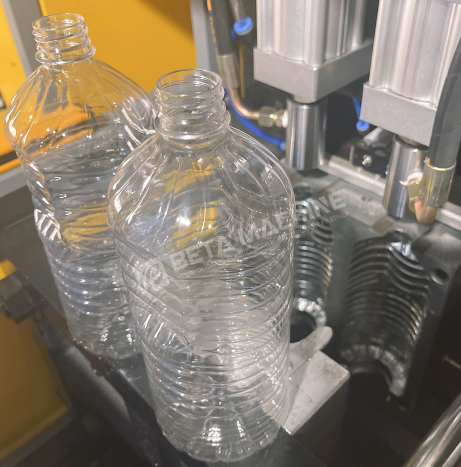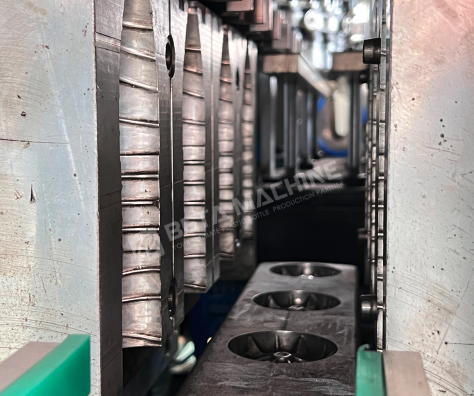Language
Views: 0 Author: Site Editor Publish Time: 2025-09-17 Origin: Site
Blow moulding is one of the most important plastic manufacturing processes in the world today. It allows manufacturers to create hollow plastic products quickly, consistently, and at scale. From everyday water bottles to heavy-duty carrying cases for sensitive equipment, blow moulding has become a standard choice across many industries.
But like every manufacturing process, blow moulding comes with both advantages and disadvantages. Understanding these factors helps businesses decide whether it’s the right process for their needs, or whether alternatives such as rotational moulding or injection moulding would be more suitable.
In this article, we’ll explore the advantages and disadvantages of blow moulding, examine the role of machines like the stretch blow moulding machine and Automatic Bottle Blowing Machine, and compare this process to other manufacturing methods.
Blow moulding is a process used to make hollow plastic products by inflating a heated plastic tube (called a parison or preform) inside a mold. Air pressure forces the plastic against the mold walls, creating the desired shape. Once cooled, the mold opens, and the finished product is released.
There are several types of blow moulding:
Extrusion Blow Moulding (EBM): Ideal for larger containers, tanks, and cases.
Injection Blow Moulding (IBM): Used for precision parts such as small bottles and medical containers.
Stretch Blow Moulding (SBM): Common for PET bottles, offering improved strength and clarity.
Machines such as the stretch blow moulding machine and Automatic Bottle Blowing Machine allow manufacturers to automate and scale production, making blow moulding a cost-effective choice for mass manufacturing.

Blow moulding remains a popular manufacturing process for many reasons. It is efficient, flexible, and produces strong, cost-effective products. Below are its major advantages.
Blow moulding is designed for speed and efficiency. Modern Automatic Bottle Blowing Machines can produce hundreds of bottles in an hour. This high-speed production capability is unmatched by other processes like rotational moulding, which might only deliver 1–2 parts per hour. The rapid production rate of blow moulding makes it ideal for industries that require millions of units annually.
High-Volume Output: Blow moulding can produce a large number of parts in a short amount of time, making it suitable for high-volume production runs.
Short Cycle Times: The process is designed to minimize cycle times, ensuring that production can be completed quickly and efficiently.
Automation: Modern blow moulding machines are highly automated, reducing the need for manual labor and minimizing the risk of human error.
| Process Type | Average Output per Hour |
|---|---|
| Blow Moulding | 60–70 parts |
| Rotational Moulding | 1–2 parts |
Although the initial tooling costs for blow moulding can be high, the process becomes highly cost-effective for large-scale production. Once the molds are created, the per-unit cost drops sharply. For beverage companies producing millions of bottles, the stretch blow moulding machine is an economical choice. The cost savings from reduced material waste and efficient production make blow moulding a financially sound option.
Affordable for Mass Production: The economies of scale make blow moulding cost-effective for large production runs.
Quick Return on Investment: After the initial setup costs, the per-unit cost decreases significantly, allowing for a quick return on investment.
Lower Material Waste: Compared to some other manufacturing processes, blow moulding generates less material waste, further reducing costs.
Blow moulded items are known for their strength and durability. They can withstand impacts and rough use, often outperforming metal alternatives in impact tests. Carrying cases, for example, often bend without cracking, making them highly reliable and long-lasting.
Single-Piece Design: The single-piece construction of blow moulded products improves their overall strength and durability.
Options for Double-Wall Protection: For added strength, double-wall designs can be incorporated into the blow moulding process.
Resistance to Dents, Cracks, and Wear: Blow moulded products are resistant to dents, cracks, and general wear and tear, ensuring a long service life.
Blow moulding supports a wide range of creative designs. Bottles can be customized with unique neck shapes, curves, or handles. Foam inserts can be added to carrying cases for additional functionality. Adjustments in wall thickness can reinforce specific sections for added strength.
Wide Range of Customization: Blow moulding allows for a high degree of customization, enabling the production of unique and functional designs.
Branding and Logos: Branding and logos can be built into the design, providing a seamless and professional look.
Scalable: The process is scalable, allowing for the production of everything from tiny containers to large tanks.
Blow moulding can also be an environmentally friendly option. Many blow moulded products are made from recyclable materials, and the process itself generates less waste compared to other manufacturing methods. This makes blow moulding a sustainable choice for environmentally conscious manufacturers.
The automated nature of blow moulding ensures consistent product quality. Each unit produced is identical, reducing the risk of defects and ensuring that every product meets the same high standards. This consistency is crucial for industries where product uniformity is essential.
Blow moulding is compatible with a variety of materials, including high-density polyethylene (HDPE), polypropylene (PP), and polyethylene terephthalate (PET). This versatility allows manufacturers to choose the most suitable material for their specific application, whether it’s for food and beverage containers, automotive parts, or industrial storage tanks.

Despite its many strengths, blow moulding has some weaknesses that must be considered.
Blow moulding requires expensive molds. For businesses producing only small quantities, this upfront cost may not be justified.
Not ideal for short production runs
High investment before cost savings
Better suited for large, ongoing orders
While blow moulding is versatile, it cannot match rotational moulding when it comes to complex shapes. Undercuts, sharp corners, or multi-layer walls are difficult or impossible to achieve.
| Process Type | Best For |
|---|---|
| Blow Moulding | Hollow, simple shapes |
| Rotational Moulding | Complex, detailed designs |
| Injection Moulding | Solid, precision parts |
Even advanced systems like the stretch blow moulding machine may produce uneven wall thickness. Weak spots can form, especially in large products.
Thickness control requires precision
Uneven distribution reduces durability
Rotational moulding often performs better in this area
Blow moulding primarily uses petroleum-based plastics such as HDPE and PET. While recyclable, these materials contribute to plastic waste challenges.
Limited material variety compared to other methods
Recyclable but not biodegradable
Environmental concerns remain despite recycling efforts
| Advantages | Disadvantages |
|---|---|
| Fast production with Automatic Bottle Blowing Machine | High initial tooling cost |
| Cost-effective for high-volume runs | Limited design complexity |
| Durable and impact-resistant products | Wall thickness variation |
| Flexible customization via stretch blow moulding machine | Petroleum-based material limits |
When choosing between blow moulding, rotational moulding, and injection moulding, it’s important to weigh the trade-offs.
Blow Moulding: Best for hollow, simple shapes in large quantities.
Rotational Moulding: Ideal for complex, low-volume products with uniform wall thickness.
Injection Moulding: Perfect for solid, high-precision parts.
This comparison highlights why blow moulding dominates in packaging and cases, while rotational moulding serves tanks and complex items.
Blow moulding becomes cost-effective for large production runs because the per-unit cost drops sharply once the molds are created. The high-speed production capability and reduced material waste contribute to significant cost savings over time.
Blow moulded products are known for their strength and durability due to their single-piece construction and resistance to impacts. Options for double-wall protection and reinforced sections further enhance their durability.
Blow moulding allows for a wide range of customization, including unique neck shapes, curves, handles, and branding elements. Adjustments in wall thickness can also be made to reinforce specific sections for added strength.
Blow moulding requires expensive molds, which can be a significant upfront investment. This makes it less suitable for short production runs or businesses with limited budgets.
Even advanced systems like the stretch blow moulding machine may produce uneven wall thickness, leading to potential weak spots. This can reduce the durability of large products.
Blow moulding remains a cornerstone of plastic manufacturing. Its advantages—speed, cost-effectiveness, durability, and flexibility—make it the first choice for industries needing high-volume hollow products. Machines like the stretch blow moulding machine and Automatic Bottle Blowing Machine have only strengthened its position, making mass production faster and more efficient than ever before.
However, businesses should also weigh its disadvantages: high tooling costs, limited design complexity, wall thickness issues, and material concerns. For low-volume or highly complex parts, rotational or injection moulding may be better alternatives.
Ultimately, the decision depends on production volume, budget, design needs, and sustainability goals. For large-scale bottle production, protective cases, and durable containers, blow moulding continues to be the most practical and efficient solution. BETA PLASTIC MACHINERY provides advanced blow moulding machines and expert support, helping businesses achieve efficiency and quality at scale.